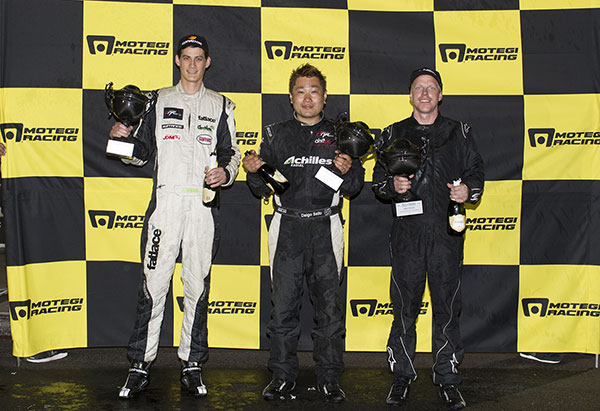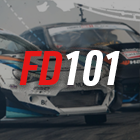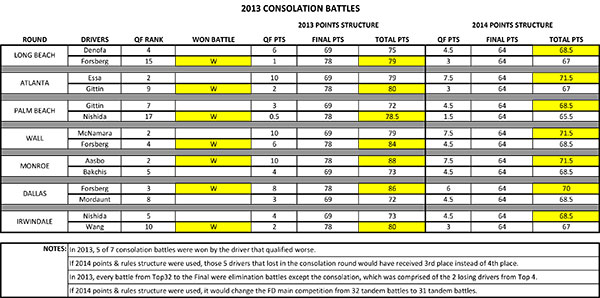Long Beach, Calif. – March 17, 2014 – Formula DRIFT deepens commitment to making competition the most exciting in motor sports by enacting more changes to the Sporting Regulations.
The changes that have been made are in the following areas:
PRO CHAMPIONSHIP AND QUALIFYING POINTS STRUCTURE
CHAMPIONSHIP POINTS AWARDS
COMPETITION
1 – 100
2 – 80
3-4 – 64
5-8 – 48
9-16 – 32
17-32 – 16
QUALIFYING
1 – 10
2 – 7.5
3 – 6
4-8 – 4.5
9-16 – 3
17-32 – 1.5
PRO CHAMPIONSHIP AND QUALIFYING POINTS STRUCTURE
Automatic Formula DRIFT PRO License renewal = Top 32 and above ranking in Formula DRIFT PRO
Automatic Formula DRIFT PRO2 License renewal = 64 points in Formula DRIFT PRO2
FORMULA DRIFT PRO COMPETITION LICENSE
Formula DRIFT PRO drivers that have earned a rank of 32 and above in the previous season will automatically be eligible for a Formula DRIFT PRO license the following year.
All remaining drivers and any new driver wishing to obtain a provisional Formula DRIFT PRO license will have two (2) options. Provisional licenses will be valid for the season for which it was granted and for the number of events specified
Option 1: FORMULA DRIFT PRO2 CHAMPIONSHIP
Competitors wishing to obtain a Formula DRIFT PRO license have the option to compete in a Formula DRIFT PRO2 series. Competitors at the end of the PRO2 Championship season will be awarded Formula DRIFT PRO license based on their final standing in the PRO2 Championship. Formula DRIFT PRO2 series competitions will be judged by Formula Drift Judges at selected Formula DRIFT PRO Championship rounds. Courses will be the same as the Formula DRIFT PRO Championship course used during that round.
Option 2: PETITION
A driver that believes that he/she is qualified to compete in Formula DRIFT PRO Championship on a competitive level but chooses to not to compete in a Formula DRIFT PRO2 Championship may submit a petition to Formula DRIFT for review. The petition application format may be obtained by contacting the Formula DRIFT office. After a reasonable review period, Formula DRIFT will notify the driver on the status of their request. Driver’s with insufficient experience or credentials will not be considered and will be notified that they must obtain a license through Formula DRIFT PRO2 series. Upon approval of the petition, Formula DRIFT will grant a provisional license. The petition will be reviewed by the Formula DRIFT licensing committee.
The Formula DRIFT licensing committee members are:
Jim Liaw President, Co-Founder Ryan Sage Vice President, Co-Founder Formula DRIFT Judges
FORMULA DRIFT PRO2 COMPETITION LICENSE
Formula DRIFT PRO2 drivers that have earned 100 points in the previous Formula Drift PRO2 season will automatically be eligible for a Formula Drift PRO2 license the following year.
Formula DRIFT PRO drivers that have earned a rank of 16 and above in the previous season will not be eligible for the Formula DRIFT PRO2 Championship the following year.
All remaining drivers and any new driver wishing to obtain a provisional Formula DRIFT PRO2 license will have two (2) options. Provisional licenses will be valid for the season for which it was granted and for the number of events specified. Failure to perform competitively in a Formula DRIFT event and/or acquire any competition points will result in revocation of the provisional license.
Option 1: FORMULA DRIFT LICENSING SERIES (i.e. FD Asia Championship, FD PRO-AM Series, etc)
Competitors wishing to obtain a Formula DRIFT PRO2 license have the option to compete in a Formula DRIFT licensing series. Each of these approved affiliate Series operate a regionally based points series with a minimum of four (4) rounds. Competitors at the end of the licensing series season will be awarded Formula DRIFT pro Licenses based on their final standing in the series championship. Formula DRIFT licensing series competitions will be judged by officials selected through operating agencies approved by Formula DRIFT. Courses will be set up to replicate the speed and dynamics of a typical course in a Formula DRIFT Pro Championship event. Each licensing series may have their own rules and regulations so all competitors must contact the licensing series directly. For the most updated list of Formula DRIFT licensing series, please refer to Appendix D.
Option 2: PETITION
A driver that believes that he/she is qualified to compete in Formula DRIFT PRO2 Championship on a competitive level but chooses to not to compete in a Formula DRIFT licensing series may submit a petition to Formula DRIFT for review. The petition application format may be obtained by contacting the Formula DRIFT office. After a reasonable review period, Formula DRIFT will notify the driver on the status of their request. Driver’s with insufficient experience or credentials will not be considered and will be notified that they must obtain a license through Option 1. Upon approval of the petition, Formula DRIFT will grant a provisional license. The petition will be reviewed by the Formula DRIFT licensing committee.
The Formula DRIFT licensing committee members are:
Jim Liaw President, Co-Founder Ryan Sage Vice President, Co-Founder Formula DRIFT Judges
Please refer to Appendix E – Formula DRIFT PRO and Formula DRIFT PRO2 Factsheet
PROTESTS IN COMPETITION
LODGING A PROTEST
A protest based on a judges call occurring during competition shall be made prior to the start of the following round of competition and is only allowed from the Great 8 to the Finals. Protests must be made prior the next round of competition. (Final Four protests must be made prior to final battle, etc).
Protests must be based on a judge’s call that was missed and that is non-subjective in nature. Such an example would be a missed, “zero” run.
Judges qualifying scores are not protestable.
The subjective areas of a judge’s score and decision are not protestable. All protests shall be made to the Driver’s Steward only.
Every protest shall be made in writing specifying which part of the Formula DRIFT Rules & Regulations is considered to have been violated, signed by the entrant or driver making the protest and accompanied by a protest fee of $50.00 within the time limits specified in these rules, and in accordance with section 4.4. The protest fee will be returned if the protest is deemed to be well-founded and is upheld by the Competition Manager.
A protest against an entry, validity of an entrant or driver, or a vehicle’s eligibility may be made at any time. All vehicle eligibility protests will be reviewed and arbitrated by the Technical Manager.
A protest against any other action of an official shall be made within 10 minutes of the action.
Notification of a protest does not guarantee that the Drivers Steward and/ or Competition Manager will hear the argument. The needs of the operation may take precedent over the protest.
QUALIFYING FORMAT AND CRITERIA POINTS ALLOCATION
QUALIFYING
The format for qualifying is a traditional format. Drivers will complete two (2) non-consecutive runs on the track in reverse order of current rank in the Championship. Drivers will receive a score after each run and the top 32 drivers will move on to Head-to-Head competition. In the event of a tie in qualifying, the tie-breaker will first be the Style points allocated followed by rank followed by logged speed.
In the event of rain or weather that does not cause cancellation of qualifying or head-to-head, the judges have the right to make adjustments to the criteria of judging and to subsequently disseminate this information to the spotters and drivers.
In the event that qualifying cannot be completed, such as a rain-out or other circumstances, qualifying order will be established by rank or by previous season points.
QUALIFYING SCORING
In qualifying, each judge will be assigned to a criterion: Line, Angle, or Style. Line judge can award up to 25 points + 10 points for Style
Angle judge can award up to 25 points + 10 points for Style
Style judge can award up to 30 points
Total maximum points is 100
In the event of a tie, the driver with the higher Style score will take the position.
GENERAL JUDGING CRITERIA FOR QUALIFYING AND HEAD-TO-HEAD COMPETITION
ITEMS THAT CONSTITUTE AN AUTOMATIC ZERO Spinning out
Clear and punctuated straightening or losing drift (Losing drift and reinitiating quickly is a major deduction, but not a zero. Judges will determine if an action results in a zero)
Two tires of course
Hood, hatch and/or doors open during a run
Resulting contact causes an abrupt change in the vehicles drift and/or causes a spin
TANDEM ELIMINATION ROUNDS
32 drivers will compete in single elimination head-to-head battles and win his/her way through a standard 32-Driver bracket. Tandem rounds are based on two (2) runs, in head-to-head format, with competitors paired up based on qualifying position. The higher qualifier will lead the first run and the second led by the lower qualifier.
Starting in 2014, there will no longer be a 3rd place consolation round. 3rd place will now be decided based on the highest qualifier of the two losing competitors in the Final Four.
LEAD CAR
The lead car is to drift the course using the line, angle and style as defined by the judges for qualifying. Typically, the lead car should driver 90 percent of his/her qualifying run(s) and focus specifically on hitting all clipping point and zones with the maximum line, angle and style as possible.
CHASE CAR
In general, the chase car needs to treat the lead car as a moving clipping point and showcase more angle and style while in chase. With regards to proximity, a chase driver may get as close to the lead car as possible as long as the chase car’s front wheels DO NOT reach in front of the lead car’s front wheels. In essence, if done properly, a chase driver can be door-to-door with the lead car without being in violation of being on a lower line. Drivers that do surpass the lead drivers front wheels will receive a deduction for their chase run. For a chase car to show true dominance to the lead car, the driver must follow the line the lead driver chooses, maintain consistent and larger angle than the lead car and use the vehicles power to maintain consistent and close proximity to the lead car.
PASSING
Passing is allowed in Formula DRIFT. Passing is allowed anywhere on course as long as the lead car is clearly off the line the judges have specified. Any passing that occurs outside the scope of the aforementioned criteria will be deemed illegal and constitute an equivalence to a zero (0) run. A chase driver will be considered the lead driver once a legal pass has been completed and clearly shows the original chase driver has assumed control as the lead driver.
ITEMS THAT CONSTITUTE AN AUTOMATIC ZERO
The following constitute a ZERO in tandem: Spinning Out
Clear and punctuated straightening or losing drift (Losing drift and reinitiating quickly is a major deduction, but not a zero. Judges will determine whether or not this is a zero)
Two tires or more clearly off course
Contact to the other driver that is considered, “avoidable”.
A chase driver not actively chasing the lead driver after the opponent had, “zero’d” out on the prior run
GENERAL
Judges may also use logged drivers speed as a reference or assistance in judging, but speed of drivers is typically used for entertainment purposes, such as those purposes served through TV, live and live stream.
USE OF REPLAYS IN COMPETITION
REPLAYS
Use of multiple replays in tandem competition is prohibited until Great 8 onward. The typical run of show will be a replay after each run of tandem, but nothing more until the Great 8 has started. Once the great 8 has started, judges may request multiple replays. The Competition Manager may request that time be allocated for a replay in any round if a technical issue has occurred that could affect a judging call.
“We are excited to start off our eleventh season with the motif of, “Dawn of a New Decade,” and with that comes changes to the competition that we feel will enhance the show by making it more thrilling, while keeping the flow consistent and in-line with what we consider to be the most electrifying motor sport on the planet,” says Ryan Sage, Vice President and Co-Founder of Formula DRIFT.






